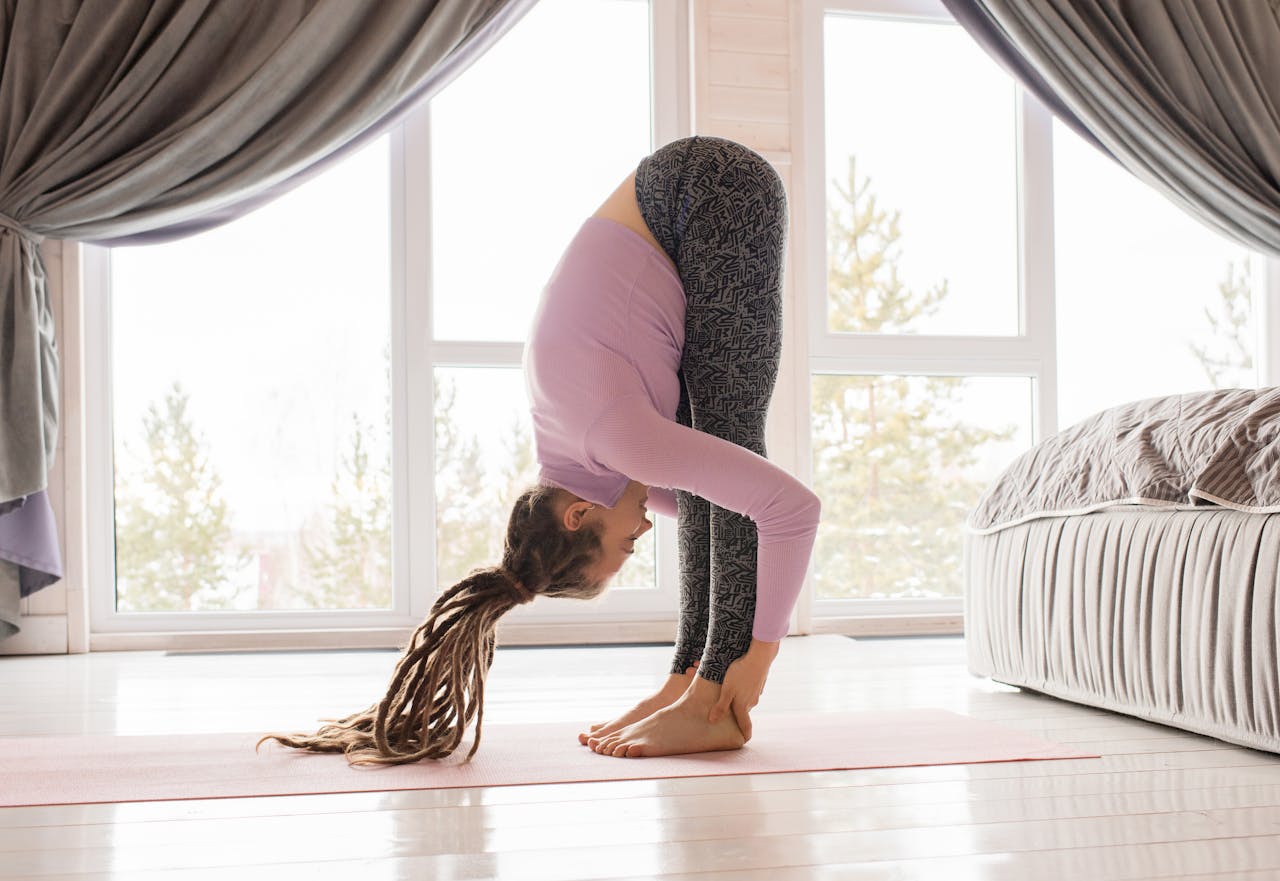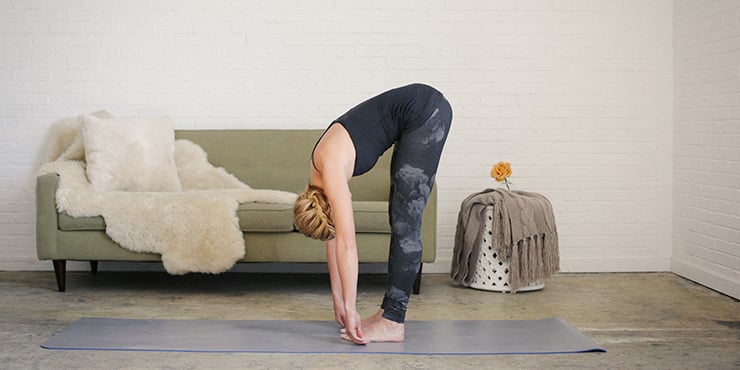
Table of Contents
Padangusthasana is a yoga asana known as the "big toe pose." The standing forward bend stretches the hamstrings, calves, and lower back muscles. To practice Padangusthasana, one needs to stand with feet together and slowly bend forward to touch the toes with the fingertips. The pose helps to improve flexibility, relieve stress, and calm the mind.
The Toe-Hold Pose in Yoga
Padangusthasana is a standing-forward bend requiring yoga practitioners to grab their big toes. It's the first standing pose in the Ashtanga Primary Series of yoga poses, which follows sun salutations. The word "Padangusthasana" derives from Sanskrit, where "pada" means foot and "angushta" means thumb, representing the big toe of the foot. This yoga asana is common in most yoga practices, including hatha yoga, ashtanga yoga, and Bikram yoga. Padangusthasana opens two of the seven main chakras: the third eye chakra, which supports practitioner wisdom, intellect, and intuition, and the sacral chakra, which relates to emotions and creativity.
How to perform Padangusthasana
Begin by standing in Tadasana (Mountain Pose). Take a deep breath, and fold forward from the hips on an exhale, keeping your back flat. Bend the right knee and bring the right foot up to rest against the inside of your left thigh. Grab the big toe with both hands, or use a strap if needed. Keep the shoulders and neck relaxed as you gently press into the right leg. Hold this pose for five to ten breaths before releasing and repeating on the other side.
Benefits and contraindications of Padangusthasana
Padangusthasana has many profound benefits that show through the human body’s response, including:
- Increases overall body strength: This posture strengthens the lower back and leg muscles, improving balance and concentration.
- Improves body flexibility: The pose stretches the hamstrings offering relief for those with flat feet.
- Relieves back pain: In many people, the psoas major is tight and weak. Padangusthasana strengthens the psoas major and is of particular importance, as it attaches each lumbar vertebrae to the tops of the inner thigh.
- Stimulates the abdominal organs: Padangusthasana stimulates the abdominal muscles to improve digestion, relieve menstrual discomfort, and energize the reproductive organs.
- Reduces stress and anxiety: The posture calms the mind and relieves muscle tension.
- Alleviates fatigue: Padangusthasana helps improves circulation, which increases energy levels.
While the posture has profound benefits, it is too strenuous for the body for pregnant women. Those with knee injuries, high blood pressure, and vertigo should avoid inversions like Padangusthasana.
Understanding hamstring and hip flexor anatomy
Padangusthasana and other forward bends can both strengthen and stretch the hamstrings. The hamstrings run up the back of the thigh and cross the knee and hip joints. They attach to the sitting bones or ischial tuberosities in the hip bones. The hip flexors are muscles that oppose the hamstrings and include the sartorius, rectus femoris, and tensor fascia latae. They attach to the hip bones' bony projections and work on both hip and knee joints.
To activate both sets of muscles, create a downward pull on the sitting bones and bony projections of the hip bones. Maintain the friction and allow the sitting bones to move upward while pulling down on the bony projections. This helps one feel their hip flexors and hamstrings and use them against each other.
By memorizing this sensation, people can learn to activate their thigh muscles by recreating it. This gives them another option to engage the muscles along the front of their legs.
Active hamstring relaxation in Padangusthasana
Instead of focusing on activating the hamstrings in Padangusthasana, try relaxing them for a deeper forward bend. Support the upper body weight with the hands resting on yoga blocks or shins. If holding onto the big toes, push the knuckles of the hands into the floor for support.
Allow the hamstrings to relax and gradually increase the fold forward while maintaining the relaxation. Try alternating between relaxing with supported hands and then activating by lifting them. Repeat the process slowly and smoothly a few times.
Focus on keeping the torso stationary while lifting the hands, sinking deeper when putting them down, and relaxing the hamstrings. Alternatively, try sinking deeper when lifting the hands and giving the body a break when putting them down.
When holding onto the big toes in Padangusthasana, change the hand action by alternating between pressing down on the floor and pulling up on the toes.
Hamstring activation without grabbing big toes
Practitioners do not need to grab their big toes to activate their hamstrings. One can exert the hamstrings against the torso or engage the hip flexors to provide an opposing force. Yoga practitioners can alternate using their arms and legs to resist the hamstrings.
What occurs when touching the big toes in Padangusthasana
To understand the benefits of grabbing the big toes in the big toe pose and pushing against the legs, it's essential to understand that while Padangusthasana can stretch the hamstrings, it's possible to stretch other muscles while they are active as well.
When one grabs the thumbs of the feet and pushes against them, the hamstrings will engage. Despite being active, they can still lengthen and gradually move deeper into the pose by extending the hamstrings. To do this, deepen the bend in the elbows.
Padangusthasana in the Ashtanga Primary Series
 Integrating Padangusthasana into the Ashtanga Primary Series involves a vinyasa, a breath-synchronized movement, for entering the pose and moving into the next pose, Padahastasana.
Integrating Padangusthasana into the Ashtanga Primary Series involves a vinyasa, a breath-synchronized movement, for entering the pose and moving into the next pose, Padahastasana.
Stand straight in Tadasana, or Mountain Pose, inhaling and stepping the feet hip-width apart. Lift the chest, inhale, and exhale into a forward bend, grabbing the big toes with the first two fingers of each hand. Inhale again, straightening the arms, and direct the gaze ahead. One can exert their arms against the legs by maintaining tension with the previous exhale. Slowly look down and back (between the legs), and bend the spine forward.
Maintain balance in Padangusthasana and hold for five smooth inhales and exhales. While breathing deeply, actively press the shoulders down, and keep the kneecaps lifted and the legs straight. Inhale and look forward, then place the hands beneath the feet with the fingers pointing back. Exhale into Padahastasana.
Alternative ways to perform Padangusthasana
If one struggles to reach their big toes, they can use a yoga strap around their feet to apply arm strength against the legs. If a strap is not accessible, grasp the sides of the yoga mat while standing sideways to increase the grip. When using a strap or yoga mat, exert the arms by pulling up on the strap while simultaneously resisting with the feet.
Strengthening with a strap
A yoga strap helps practitioners make the body flexible and strong. Gently lower and increase the pull and adjust the belt's position if necessary. Placing the strap under the forefeet can improve the stretch.
Shift the body weight forward so the forefeet press down on the strap. Use the calf muscles to resist the lifting of the forefeet. The tendons of the hamstrings and calves intersect at the back of the knees. Activate the calves to anchor the bottom end of the hamstrings, adding mobility to the forward folding motion.
Knee-Bending in big toe pose
To reach the big toes, bend the knees and grab them while exerting arms against the legs. Gradually get the knees straight while maintaining this opposing action.
Alternatives for reaching for the big toes
If one struggles to bend forward and touch their big toes in Padangusthasana, they can use a stable chair or yoga blocks as support.
Alternatively, one can place their hands on their shins, waist, above the head, or past the hips. One can also try reaching backward to grasp their big toes and lifting them upwards, as in Prasarita Padottanasana C. The more one practices this posture, the more body flexibility one will gain.
Big toe pose variations
Utthita Hasta Padanguthasana
If practitioners are up for a challenge, this is an advanced variation of Padangusthasana. Here are some simple steps to the extended hand to big toe variation:
- Begin by standing in Tadasana (Mountain Pose).
- Maintaining balance on the left leg, bend the right knee and lift the leg upwards.
- Reach the right hand for the right big toe with the thumb and middle finger.
- Keep the standing leg straight, shoulders down, and back tall.
- If one cannot reach their toe, one can use a strap.
- Extend the left hand straight up towards the sky and hold the pose for five breaths.
- Carefully lower the lifted leg back into the mountain pose.
- Repeat on the right side.
Supta Padangusthasana
Supta Padangusthasana is a reclined version of Utthita Hasta Padangusthasana, performed by lying on the back and holding the big toe of one foot. This pose is part of the second half of seated ashtanga poses, following the boat pose.
The steps to Supta Pangusthasana are as follows:
- Lie on the back with the legs flat on the ground.
- Bend the right knee and hug it into the chest.
- Place a yoga strap around the right food, holding the ends of the strap with both hands.
- While balancing on the left foot, extend the right leg toward the ceiling and stretch the right leg with a flexed foot. Keep the right hip in line with the left hip.
- Hold the posture for five to ten breaths.
- Repeat on the left side.
Common mistakes in Padangusthasana and their corrections
Padangusthasana is prone to several mistakes, such as grabbing the big toes with excessive forward bend in the spine. This happens when the hamstrings are too tight, and the spine bends forward, neglecting the hips.
Correct this by practicing the spinal erector activation in Shalabasana (Locust Pose) and duplicating the feeling in a standing forward bend. This will help one understand how far they are bending their spine.
Another correction is to focus on feeling the pelvis and hip bones instead of reaching the chest towards the legs. Practice focusing on the hip bones, such as the ASICs and sitting bones, and tilt them forward while doing Padangusthasana and other forward-bending yoga poses.
References
Effect of Iyengar yoga therapy for chronic low back pain - ScienceDirect
Big Toe Pose (Padangusthasana)
What is Jagat? - Definition from Yogapedia
Disclaimer
The contents of this article are provided for informational purposes only and are not intended to substitute for professional medical advice, diagnosis, or treatment. It is always recommended to consult with a qualified healthcare provider before making any health-related changes or if you have any questions or concerns about your health. Anahana is not liable for any errors, omissions, or consequences that may occur from using the information provided.

By: Anahana
The Anahana team of researchers, writers, topic experts, and computer scientists come together worldwide to create educational and practical wellbeing articles, courses, and technology. Experienced professionals in mental and physical health, meditation, yoga, pilates, and many other fields collaborate to make complex topics easy to understand.
